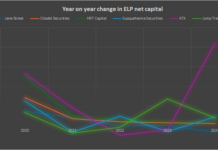What’s all this fuss about new capital rules? The US Federal Reserve has decided that some banks, with over US$100 billion in assets, need to be better capitalised and that could make it more expensive to trade.
Is this because some banks went bust? Precisely! After Silicon Valley Bank (SVB) and other regional banks fell over, the authorities want to see more protection for banks. By which they mean a bigger buffer against a collapse.

Why did those banks collapse anyway? Well, the Fed says it was a lack of transparency and accounting for unrealised losses which left the banks under capitalised. That is disputed, but Michael Barr, vice chair for supervision, says, “It was an unsuccessful attempt by SVB to raise capital that caused uninsured depositors to look more closely at how the bank was capitalised.”
What do other people think? Some people blame supervision – and Barr acknowledges some include the Fed in that – and many blame SVB’s management more directly. He responds, “It is not a choice between supervision and capital regulation — capital is and has always been the foundation of a bank’s safety and soundness.”
So, what is the Fed doing? It is imposing standardised measures to try and reduce the risk of a bank missing risks they are exposed to. No rush – proposed changes are ratified, banks will have until July 2028.
How much more capital will be needed? If the new capital measures suggested are ratified and applied, they would be equivalent to the biggest banks have an extra US$2 of capital for every US$100 of risk-weighted assets, a net increase of 16% capital across the banking sector.
What has this got to do with trading? Firms will have to model market risk at the individual trading desk level for particular asset classes, instead of at the firm level, raising overall market risk capital requirements. That’s because the Fed says there are gaps in the current rules and it wants correlations across risks, which it notes can change dramatically in times of stress, to be better tracked.
Come again? They don’t think risk managers fully understand what is happening when markets go crazy.
Anything to worry about? Depends on who you are – the “largest, most complex banks” are in scope for the biggest of the changes according to Barr. Law firm Mayer Brown, says, “Banking organisations are likely to expend considerable resources to control and document the market risk activities of trading desks under the Capital Proposal.”
So how could trading be affected? In simple terms, the more it costs banks to manage trading, the more banks pass costs on to the market. There is still time to make comments on the proposals, until 30 November 2023, and even the rules are agreed they will be phased in between 2025 and 2028, so don’t panic.
©Markets Media Europe 2023
©Markets Media Europe 2025














